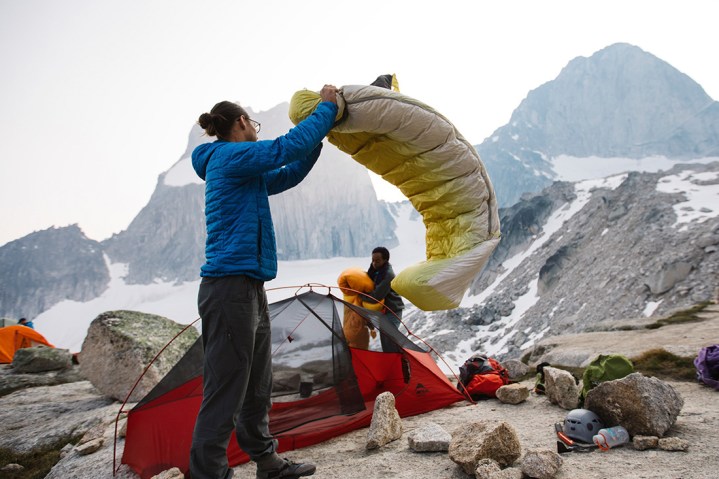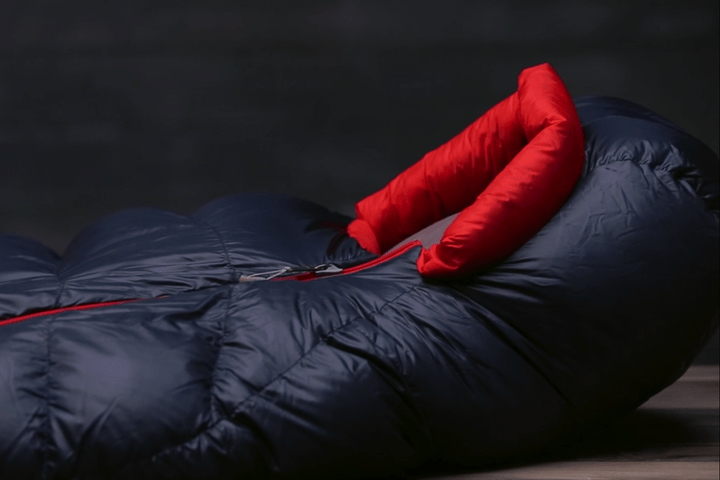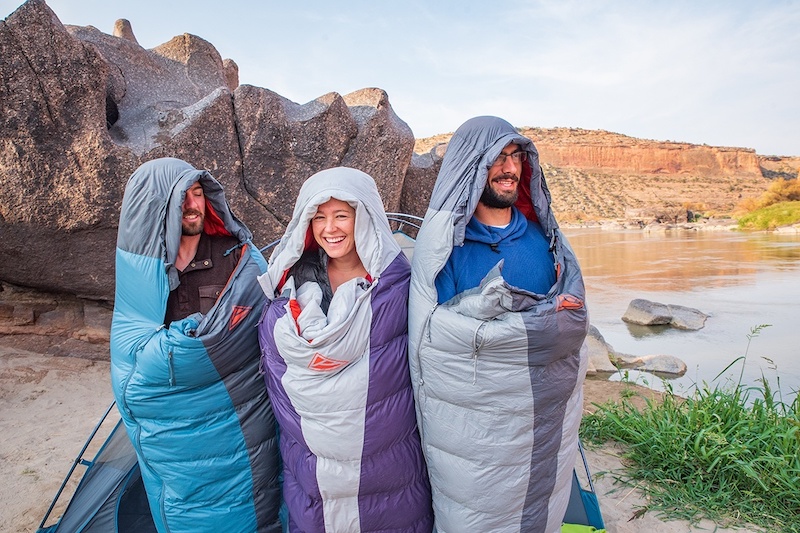
There’s nothing quite like slipping into a warm sleeping bag after a long day of hiking. Whether you’re heading out for an overnight camping trip, or backpacking the entire length of the Appalachian Trail, having the right sleeping bag is the key to getting a good night’s sleep in the backcountry. Choosing the right bag isn’t just about warmth and comfort, however, as other factors like weight, size, and packability play an important role too. Beyond that, you’ll want to take into account the weather, location, and season, as each of those variables can have an impact on how a sleeping bag performs in the wild.
- The best overall: REI Co-Op Magma 15
- The best for the budget-conscious: Kelty Cosmic 20
- The best for the ultralight backpacker: Therm-a-Rest Hyperion 32
- The best for cold temperatures: Nemo Sonic
- The best synthetic bag: Mountain Hardwear Lamina 30
- The best backpacking quilt: Kammok Firebelly Trail Quilt
- Things to consider
To help you decide which bag is best for your next backpacking trip, we’ve combed through the sea of available options to find the very best. These are our picks for the best sleeping bags available for backpackers right now.
The best overall: REI Co-Op Magma 15

If you’re looking for a good all-around sleeping bag that combines performance and price in a versatile package, it’s tough to top the REI Co-Op Magma 15. Comfortable and roomy, this bag offers a generous amount of space in both the leg and foot area, while still maintaining a fitted shape that plays a crucial role in heat retention. Add in 850-fill hydrophobic down insulation and you get a sleeping bag that is comfortable even in temperatures as low as 15 degrees Fahrenheit. Durable zippers, water-resistant shell fabrics, a pillow-compatible hood, and the ability to compress down to a surprisingly small size allow the Magma 15 to outperform plenty of bags that cost considerably more.
There are certainly less expensive options on the market, but with the Co-Op Magma 15, REI has delivered outstanding value for the money. This is a warm and comfortable sleeping bag that performs well in a wide variety of settings and seasons, making it a good choice for the backpacker who only wants or needs a single bag for all of his or her outdoor adventures.
The best for the budget-conscious: Kelty Cosmic 20

Let’s face it, not all of us have hundreds of dollars to spend on a sleeping bag, especially if we’ve upgraded our other backpacking gear too. Thankfully, there are some good budget options available that can help us save some cash and still enjoy our overnight camping excursions. The best of those is the Cosmic 20 from Kelty, a bag that doesn’t break the bank but still manages to offer some excellent features. For example, Kelty has used 600-fill waterproof down as an insulator, along with a durable 20D nylon outer shell. Inside, you’ll find a soft lining and a cozy hood, allowing you to remain comfortable even when the mercury drops to 20 degrees Fahrenheit. Add in easy-pull zippers, three sizes, and a roomy cut, and you have a great sleeping bag for the price.
The downside of the Kelty Cosmic 20 is that it weighs a bit more than most of the other bags on our list, tipping the scales at 2 pounds, 4 ounces. That is still relatively light for the price, but it is one of the trade-offs when buying a more budget-friendly sleeping bag. Still, the all-around performance that the Kelty Cosmic 20 offers is worth a few extra ounces in your backpack when it also means a few extra bucks in your wallet.
The best for the ultralight backpacker: Therm-a-Rest Hyperion 32

When it comes to creating sleep systems for backpackers, Therm-a-Rest knows what it’s doing. The company makes the best sleeping pads on the market, along with some outstanding sleeping bags. Those looking to cut ounces from their pack are going to want to give the Hyperion 32 a look, as this bag weighs less than a pound and still manages to keep backpackers warm in temperatures as cool as 32 degrees Fahrenheit. The Hyperion features 900-fill waterproof down, an ergonomic shape designed to hug the body, and built-in connectors that integrate nicely with a sleeping pad. Best of all, this sleeping bag packs down incredibly small, taking up a minuscule amount of room in your backpack.
Best for use in warmer weather, the Therm-a-Rest Hyperion 32 is a fantastic option for ultralight backpackers in particular. Its thoughtful design utilizes zoned insulation to provide warmth where you need it most and it comes equipped with extra-long zippers that make getting in and out of it less of a chore. Pair it with Therm-a-Rest’s NeoAir Uberlite sleeping pad for a comfortable backcountry sleeping solution that weighs less than 24 ounces.
The best for cold temperatures: Nemo Sonic

If you’re planning on camping outside during the winter, or your outdoor adventures happen to take you to colder climes, you’re going to need a warm sleeping bag to get you through the long nights. With its 800-fill hydrophobic down and body-hugging design, the Nemo Sonic provides a good night’s sleep even when the mercury plummets below 0 degrees Fahrenheit. The bag is built for use in alpine environments and extremely cold conditions, keeping backpackers warm year round. In fact, it is so warm that Nemo has integrated what it calls “thermo gills” into the design, allowing heat to escape from inside while preventing cold air from getting in. Recently redesigned with improved draft tubes and a better draft collar, the Sonic is now much better at maintaining a tight seal. It also features plenty of room inside, making it a good option for those who don’t like to feel confined inside their bag.
A 0-degree sleeping bag is always a bit pricier than models designed for use in warmer temperatures, but with the Nemo Sonic, you don’t have to worry about durability and long-term use, as it’s versatile enough to be used in a range of environments.
The best synthetic bag: Mountain Hardwear Lamina 30

Synthetic insulation in a backpacking sleeping bag can be a bit of a mixed bag. Down is warmer, packs down smaller, and is arguably more comfortable. But synthetic insulations can sometimes perform better in wet environments, often dry faster, are often more affordable. Case in point: Mountain Hardwear’s Lamina 30. It features a 30 degree Fahrenheit warmth rating, comes with a durable water-repellant shell, and features two-way zippers for easy ventilation. Add in a draft collar to keep out cooler air and a contoured footbox for a more natural sleeping position, and you have all of the makings of a comfortable sleeping bag at a reasonable price.
One of the frequent knocks against synthetic is that it tends to weigh more than a down sleeping bag, but the Mountain Hardwear Lamina 30 comes in a shade over 2 pounds, making it a reasonable option for warm weather outings. If you’re on a budget, camping in a wet area, or are simply looking for an alternative to a traditional down sleeping bag, then this model should be on your short list.
The best backpacking quilt: Kammok Firebelly Trail Quilt

As more and more backpackers switch to hammocks for their camping needs, an increasing number are also abandoning sleeping bags in favor of quilts. Quilts integrate more nicely with a hammock, but they are just as comfortable and cozy in a tent, particularly in warmer weather. They also have the added benefit of being lighter and easier to pack down, taking up very little room in your backpack.
That’s exactly what you’ll get with the Kammok Firebelly Trail Quilt, which is rated for use in temperatures dropping down to as low as 30 degrees Fahrenheit. This versatile blanket can serve as both a top and under quilt for hammock campers, or a lightweight sleeping bag when inside a tent. Kammock uses 750-fill hydrophobic DownTek down, which provides an excellent weight-to-warmth ratio. And since the Kammok Firebelly Trail Quilt weighs just 24 ounces and packs down to a surprisingly small footprint, it is a great choice for use on warm-weather trips. It even comes with integrated sleeping pad straps and works just as nicely as a blanket while hanging out by the fire as it does when it comes time to call it a night.
Things to consider
Temperature ratings and warmth
It’s important to understand sleeping bag temperature ratings so you can select the appropriate product for your body and sleep style. This is especially true in colder weather when hypothermia can be a concern. Quite frankly, it’s better to play it safe with regards to warmth and err on the side of caution. If conditions are toastier than expected, you can always unzip your sleeping bag and drape it over you like a blanket. Backpacking sleeping bags are usually three-season bags, rated between 10 and 32 degrees Fahrenheit.
The EN rating is the most dependable and standardized international system used by most companies — but not all. Those who use them assign two EN ratings to each bag to help you better understand its seasonal capacity based on your personal preferences. It’s better to err on the conservative side when it comes to temperature ratings. It’s also important to understand that EN ratings assume you’ll be sleeping on a pad, wearing a beanie on your head, and dressing in long underwear.
Comfort rating: This is the lowest rating that keeps the average woman or cold sleeper warm, as women tend to be colder sleepers than men,
Lower-limit rating: This is the lowest rating that keeps a man or a warm sleeper comfortable.
Warmth is associated with loft, which is determined by a height measurement of the down. Fill power indicates a sleeping bag’s ability to loft. The higher the fill power, the lighter the sleeping bag, as a higher fill power usually indicates higher grade down. Furthermore, the higher the loft, the warmer the bag.
The only exception to this rule is when you bring fit into the equation. A loose-fitting bag introduces the opportunity for increased dead air space and, as a result, cold spots — no matter what the loft may be. Backpacking bags are generally more fitted for weight-saving purposes but it’s important to pay attention to the bag’s measurements and buy a bag that properly fits your body type. Sleeping bags are usually available in Regular and Long lengths, with the Long style designed for taller people.
Synthetic vs. Down
While down sleeping bags were traditionally used exclusively for backpacking due to their unmatchable warmth to weight ratio, companies are vastly improving the quality of synthetic insulation and many synthetic sleeping bags have joined down in the backpacking ranks. Synthetic insulation is constructed from a blend of polyester materials and in many areas, down just can’t compete — highlighted by its quick-drying nature and obvious advantage in wet conditions. Other advantages of synthetic insulation include being non-allergenic and less expensive. When you don’t have a lot of money to spend on a sleeping bag, it might be worth going a little heavier and buying synthetic.
Down edges synthetic regarding warmth to weight ratio and compressibility and is also exceptionally long-lasting. If you want a sleeping bag which retains its loft for 10 to 15 years, invest your money in quality down. Another important thing to note is that down is completely useless from a warmth standpoint when wet. This is why many companies treat their down with a water-resistant application, resulting in “hydrophobic” down which, in addition to a waterproof face fabric, helps down maintain its warmth in wet conditions.
You’ll see goose down listed for some sleeping bags and duck down listed for others. Is there a difference? Yes, but both keep you immensely warm. Goose down (from mature geese) is capable of attaining higher fill values including 900+ but is typically more expensive. Many companies select duck down as their down of choice due to its abundance and decreased expense.
Women’s specific sleeping bags
Women are obviously not shaped the same as men. What this means is that if you’re a woman, there are definite advantages to buying a women’s specific sleeping bag. Women tend to have wider hips and narrower shoulders and are generally shorter than men. Companies have applied this formula to women’s specific sleeping bags, adding more width at the hips, tucking in the width at the shoulders, and making them shorter in length. In addition, since women are usually colder sleepers than men, women’s specific sleeping bags are often designed with added insulation in the upper body and/or footbox.
Weight
Total weight depends on a number of factors, including insulation weight, shell type, amount of insulation, and features. When it comes to backpacking weight, everyone has a personal preference for how much they’re willing to carry. Some people won’t mind the extra weight of a less expensive down or synthetic bag, while those who count ounces might look for the best weight to warmth ratio they can find — or opt for a half bag, such as the Patagonia Hybrid. Slimmer-cut bags also tend to weigh less, so if weight is a priority, look for a bag with a tighter fit — or perhaps fewer features.
Editors' Recommendations
- The best camper vans
- The best Cyber Monday outdoor gear deals for 2019
- The best smart helmets for 2019


